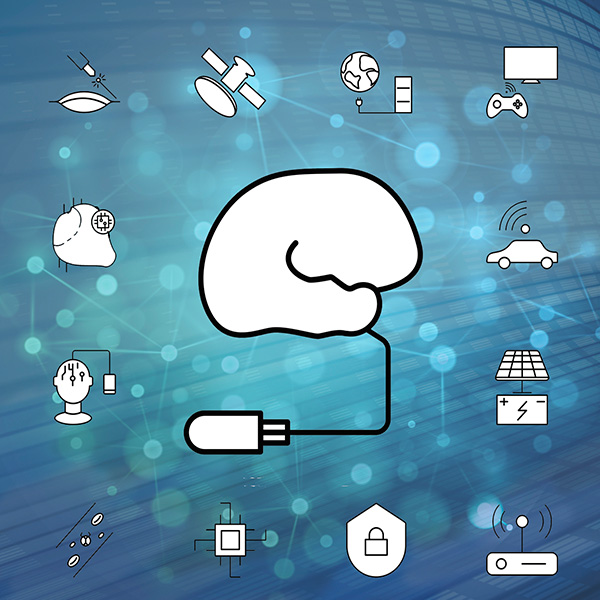About
 The goal of this program is to bring together diverse stakeholders across neurotechnologies, research institutions, industry and government agencies to identify and address gaps in the existing standards for Brain-Machine Interfacing (BMI)/Brain Computer Interface (BCI) based solutions.
The goal of this program is to bring together diverse stakeholders across neurotechnologies, research institutions, industry and government agencies to identify and address gaps in the existing standards for Brain-Machine Interfacing (BMI)/Brain Computer Interface (BCI) based solutions.
Neurotechnologies for Brain-Machine Interface Standards Roadmap Now Available!
This roadmap provides an overview of the existing and developing standards in the field of neurotechnologies for brain-machine interfacing. The focus is on systems that provide a closed-loop interaction with artificial devices based on information extracted from measurements of activity in the nervous system. The document also includes recommendations on the priorities for standardization. Please download the standards roadmap (PDF).
Interest in BMI/BCI is consistently growing and state-of-the-art research is currently being tested on its intended end-users. Translation from laboratory proof-of concepts to viable clinical and assistive solutions, as well as consumer applications entails a large set of challenges.
The possibility of deploying and commercializing BMI/BCI-based solutions requires researchers, manufacturers, and regulatory bodies to ensure these devices comply with well-defined criteria on their safety and effectiveness. BMI/BCI systems typically require integration of multiple sub-components comprising measuring and analysis of neural activity, and provision of feedback to the user through different means (including displays, virtual reality systems, haptic interfaces and exo-skeletons, among others). The lack of specific standards on neurotechnologies for BMI/BCI hinders the interoperability, and regulatory compliance of new devices and in consequence, consists a barrier for industrial applications to access a wide market.
Get Involved
We welcome new participants from academy, industry and government agencies that are interested in neurotechnologies including, but not limited neural acquisition systems (Neuroimaging, EEG, ECoG, and multiunit activity), electrostimulation at central (TMS, tDCS, tACS) and peripheral (FES) levels. Individuals who are interested in related technologies comprising virtual reality systems and gaming, haptic devices, rehabilitation robotics, as well as, wellness devices, healthcare and rehabilitation, gaming applications and others should also participate and get involved.
Possible Industry Outcomes
Proposed deliverables and outcomes from this Industry Connections activity may include documents (e.g., white papers, reports), proposals for standards, conferences and workshops, databases, computer code, etc.
Expected outcomes:
- Provide an integrated overview of all standards activity that is specifically related to BMI-related neurotechnologies
- Identify any gaps in the existing standards and suggestions on how to address these gaps
Expected impact in multiple markets including:
- Motor rehabilitation
- Assistive technologies, including neuroprosthetics, exo-skeletons, and communication devices
- Diagnosis and therapies for motor and cognitive disorders
- Health monitoring, in particular for healthy aging
- Virtual and augmented reality
- Training in industrial and military applications
- Gaming
- Cognitive training
Standard projects:
How to Participate
To learn how to join the Neurotechnologies for Brain-Machine Interfacing team, please express your interest by sending an inquiry to:
Additional Contact
Events
- Int Brain Initiative Coordinating Body Meeting (Dec 2021)
- Presentation at: IEEE SA Healthcare and Life Science (HLS) Practice (Oct 2021)
- Virtual workshop on the need of good practices and standards for benchmarking Brain-Machine Interfaces (4 March 2021)
- 1st IEEE International Conference on Human-Machine Systems, Standards in Human-Machine Systems Special Track (9 September 2020)
- 1st Brain-Computer Interface Un-Conference (23 July 2020)
- Predicting Future Tech Trends for an Immersive Intelligent Digital World (July 15th 2020)
- Standards for Neurotechnologies and Brain-Machine Interfacing Workshop (16 September 2019)
- Face to face meeting and special session Healthcare Innovation: Inspiring Global Open Consensus Standards – IEEE EMBS conference Jeju Island, Korea (14 July 2019)
- Special session on standards at the IEEE SMC 2018 BMI workshop. Miyazaki, Japan (7-10 October 2018)
- Presentation at the Meeting of the global and emerging brain initiatives. IEEE SMC 2018. Miyazaki, Japan (7-10 October 2018)
- Workshop on standards for Neurotechnologies at the International BCI meeting at Asilomar, USA (21-25 May 2018)
- Face to face meeting at the IEEE International Systems, Man and Cybernetics Conference Banff, Canada (06 October 2017)
Resources
- Neurotechnologies for Brain-Machine Interface Standards Roadmap
- Paper: International Data Governance for Neuroscience
- Paper: Towards a Governance Framework for Brain Data
- Paper: Workshops of the eighth international brain–computer interface meeting: BCIs: the next frontier
- ICAID
- Presentations from Graz Workshop (Sept 2019)
- On the Need of Standards for Brain-Machine Interface Systems
- Standardization of Neurotechnology for Brain-Machine Interfacing: State of the Art and Recommendations (PDF)
- A Roadmap towards Standards for Neurally Controlled End Effectors (PDF)
- Preliminary Minimum Reporting Requirements for Reporting In-Vivo Neural Interface Research: I. Implantable Neural Interfaces (PDF)
- A Functional Model for Unifying Brain Computer Interface Terminology (PDF)

